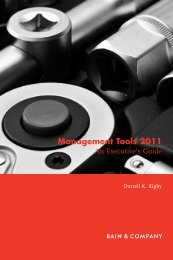Service now! Time to wake up the sleeping giant - Bain & Company
Service now! Time to wake up the sleeping giant - Bain & Company
Service now! Time to wake up the sleeping giant - Bain & Company
You also want an ePaper? Increase the reach of your titles
YUMPU automatically turns print PDFs into web optimized ePapers that Google loves.
Spotlight: human resources – Investing ahead of <strong>the</strong> curve<br />
People are often <strong>the</strong> single most important limiting<br />
fac<strong>to</strong>r in service. Without <strong>the</strong> right number<br />
of employees with <strong>the</strong> correct skills, manufacturers<br />
cannot realize <strong>the</strong>ir growth ambitions. OEM organizations<br />
often have administrative routines in <strong>the</strong><br />
hiring process that are not tuned <strong>to</strong> services and so<br />
hinder growth. Among <strong>the</strong> barriers encountered are<br />
fragmented decision making over several organizational<br />
layers, hiring policies that demand locked-in<br />
service business before hiring can commence, and<br />
problems in finding and retaining <strong>the</strong> right candidates.<br />
Having <strong>the</strong> right people requires good planning,<br />
hiring and talent management.<br />
Work out a staffing plan<br />
To achieve significant growth in services, industrial<br />
goods manufacturers need <strong>to</strong> plan and invest in<br />
human resources before <strong>the</strong> business can expand.<br />
They can deduce <strong>the</strong> required staff numbers from<br />
<strong>the</strong> market potential based on <strong>the</strong>ir installed base<br />
and <strong>the</strong>ir cus<strong>to</strong>mers’ full installations. In situations<br />
where a company’s service market share of its own<br />
equipment is less than 25%, additional hiring is<br />
almost always necessary. Investing in salespeople or<br />
technicians typically yields returns within 12 <strong>to</strong> 18<br />
months, and <strong>the</strong>se investments can be easily tracked<br />
and scaled back if <strong>the</strong> expected market success does<br />
not materialize. During <strong>the</strong> ramp-<strong>up</strong> process, it is<br />
important <strong>to</strong> keep a healthy pyramid of managers<br />
compared with engineers and technicians in order <strong>to</strong><br />
sustain service delivery and keep <strong>the</strong> promises made<br />
<strong>to</strong> <strong>the</strong> cus<strong>to</strong>mer.<br />
Prepare <strong>to</strong> invest in talent<br />
Competi<strong>to</strong>rs are gearing <strong>up</strong> for service growth, <strong>to</strong>o,<br />
which will make it difficult <strong>to</strong> find experienced candidates,<br />
especially in developed markets. Some can<br />
be wooed away from o<strong>the</strong>r companies by offering<br />
attractive compensation and career paths. But manufacturers<br />
will also need <strong>to</strong> invest in basic training<br />
for people coming out of engineering or vocational<br />
schools. In developing markets large talent pools are<br />
available, but <strong>the</strong> quality of candidates is challenging<br />
<strong>Service</strong> <strong>now</strong>! <strong>Time</strong> <strong>to</strong> <strong>wake</strong> <strong>up</strong> <strong>the</strong> <strong>sleeping</strong> <strong>giant</strong><br />
and it is difficult <strong>to</strong> retain employees. These situations<br />
require <strong>up</strong>-front investment in <strong>the</strong> right recruiting<br />
and training capacities in order <strong>to</strong> undertake<br />
a large-scale hiring, training and retention process.<br />
Establish efficient hiring processes<br />
Rapid service growth demands rapid hiring. Pre-<br />
paring job profiles in advance for each service position<br />
<strong>to</strong> be filled can help. Managers should be prepared<br />
for <strong>the</strong> screening process: A regional hub that<br />
wants <strong>to</strong> hire 100 people will need <strong>to</strong> screen 500 <strong>to</strong><br />
1,000 candidates. During <strong>the</strong> ramp-<strong>up</strong> phase, local<br />
and regional service centers should be allowed <strong>to</strong><br />
conduct blanket hiring in order <strong>to</strong> remain flexible<br />
and make <strong>the</strong>ir own choices ra<strong>the</strong>r than having <strong>to</strong><br />
wait for decisions from headquarters.<br />
Example: A dearth of trained personnel<br />
limits growth<br />
A German service provider wanted <strong>to</strong> ramp <strong>up</strong><br />
a wind turbine service business from scratch.<br />
On-<strong>the</strong>-job training proved <strong>to</strong> be <strong>the</strong> company’s<br />
main restraint on growth. Typical dispatching foresees<br />
a maximum of two service agents for efficiency<br />
reasons: one experienced technician <strong>to</strong> actually<br />
perform <strong>the</strong> service work and one new hire <strong>to</strong><br />
learn on <strong>the</strong> job. The learning period usually <strong>to</strong>ok<br />
six <strong>to</strong> 12 months until <strong>the</strong> new hire was deemed<br />
experienced enough <strong>to</strong> go out alone – though still<br />
not experienced enough <strong>to</strong> train ano<strong>the</strong>r colleague<br />
on his own. Consequently, <strong>the</strong> business’s growth<br />
was restricted by <strong>the</strong> lack of experienced service<br />
technicians <strong>to</strong> pass on <strong>the</strong>ir practical experience.<br />
This limitation had <strong>to</strong> be reflected in <strong>the</strong> growth<br />
plans and related cus<strong>to</strong>mer acquisition activities.<br />
27
















